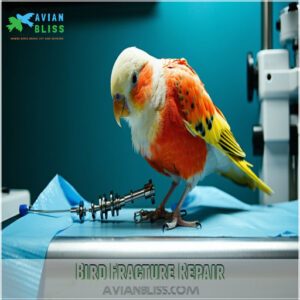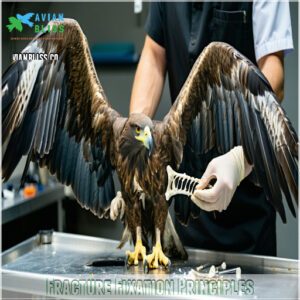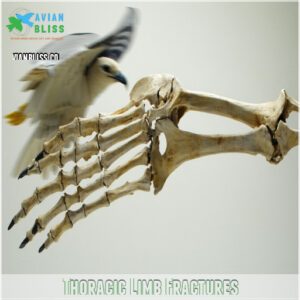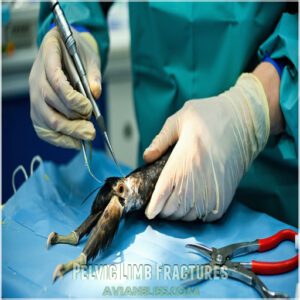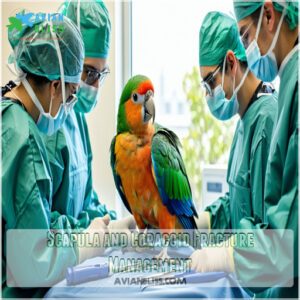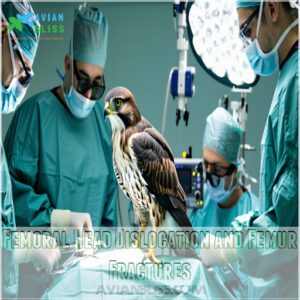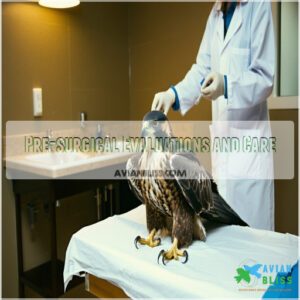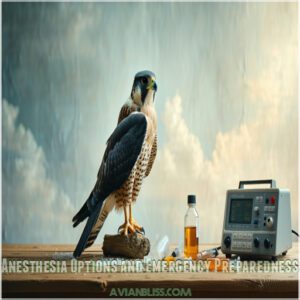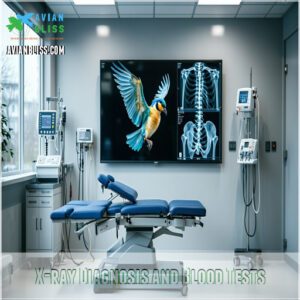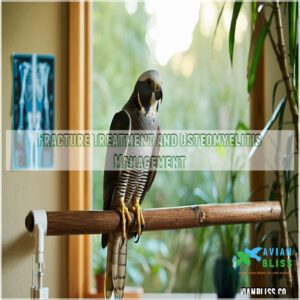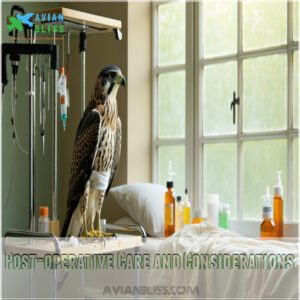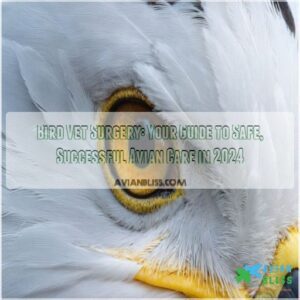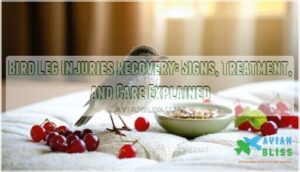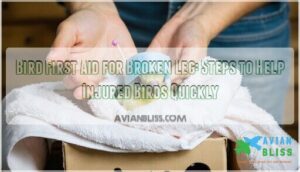This site is supported by our readers. We may earn a commission, at no cost to you, if you purchase through links.
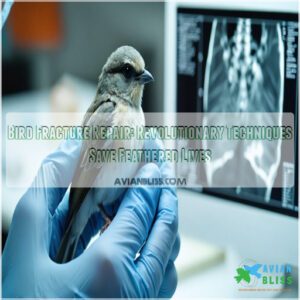
Veterinarians use specialized techniques like external fixators and titanium pins to stabilize broken bones.
You’ll need to immobilize the injury quickly, preventing further damage.
The repair process involves carefully aligning bone fragments, applying precise stabilization hardware, and managing pain.
X-rays help determine the exact fracture type, guiding treatment.
Successful repair depends on species-specific considerations, proper surgical technique, and thorough post-operative care.
Antibiotics, physiotherapy, and gradual rehabilitation are essential.
With modern avian orthopedic advances, even complex fractures can heal, giving your winged companion a fighting chance at recovery.
Table Of Contents
- Key Takeaways
- Bird Fracture Repair
- Fracture Fixation Principles
- Limb Region Fracture Management
- Avian Surgery and Diagnosis
- Post-operative Care and Considerations
- Frequently Asked Questions (FAQs)
- How do you repair a bird fracture?
- What are the methods of fracture repair?
- How long do bird fractures take to heal?
- How do you treat a bird’s leg fracture?
- How long does bird fracture healing take?
- Can all bird species undergo fracture surgery?
- What are common complications of bird fractures?
- How painful are bird bone fractures?
- Do bird fractures always require surgical intervention?
- Conclusion
Key Takeaways
- You’ll discover that modern avian orthopedics have dramatically improved bird fracture repair success rates, increasing survival from 25% to over 75% through specialized surgical techniques like hybrid fixators and titanium pins.
- Your bird’s fracture repair depends on precise pre-surgical evaluations, including detailed radiographs, species-specific considerations, and understanding the unique characteristics of avian bone structure.
- You’ll need to focus on comprehensive post-operative care, which includes targeted pain management, antibiotic protocols, species-specific physiotherapy, and careful rehabilitation strategies to maximize recovery potential.
- When treating bird fractures, you’ll face complex challenges that require expert intervention, with healing times typically ranging from 6-12 weeks and success heavily dependent on factors like injury severity, bird species, and the quality of orthopedic care.
Bird Fracture Repair
When you’ve got an injured bird with a tricky fracture, you’ll want to understand the cutting-edge techniques that can help these feathered patients recover.
You’ll discover how modern orthopedic methods like the innovative tie-in fixator have dramatically improved survival rates, transforming avian fracture repair from a risky procedure to a precise, life-saving intervention.
Avian Orthopedic Surgery Evolution
Countless veterinary surgeons have grappled with the delicate challenge of avian orthopedic surgery.
Early techniques struggled with limited success rates, often leaving injured birds with minimal hope.
The breakthrough came in the early 1990s, when innovative surgical approaches transformed bird fracture repair, dramatically increasing survival rates from roughly 25% to over 75% through groundbreaking orthopedic techniques.
This advancement in avian surgery methods has substantially improved the treatment of bird fractures, offering new hope for injured birds, which is a significant development in bird fracture repair and avian surgery.
External Fixator Modifications
Building on breakthroughs in avian orthopedics, surgeons revolutionized external fixator design to tackle birds’ unique bone challenges.
By modifying traditional external skeletal fixation techniques, they developed specialized approaches that address fragile bone structures.
These surgical innovations in fixator design dramatically improved bone stabilization, offering more precise fracture reduction methods for injured birds, which is a significant advancement in bone stabilization.
Tie-in Fixator Method
After traditional external fixators fell short, veterinary surgeons revolutionized avian orthopedics with the tie-in fixator method.
By heating flexible acrylic bars to connect external fixator components with intramedullary pins, they created a game-changing approach to fracture stabilization.
This innovative technique provides birds with a robust, durable solution for complex bone healing challenges.
The success of such procedures relies heavily on proper bird vet surgery to guarantee the best possible outcomes for the birds.
Orthopedic Repair Success Rates
Soaring hopes lift avian orthopedic surgery‘s success rates from a mere 25% to over 75%, revolutionizing fracture healing for our feathered friends.
Here’s what you need to know about orthopedic repair outcomes:
- 3D-printed prostheses dramatically improve birds’ quality of life
- Wing fracture repairs restore flight in less than a third of cases
- Rapid bone healing occurs within 2-3 weeks of proper treatment
- Calcium-rich bones challenge surgical intervention
- Species-specific factors influence overall repair success
Understanding bird bone disorders is essential for effective treatment and recovery.
Fracture Fixation Principles
When repairing bird fractures, you’ll encounter unique challenges due to their delicate bone structure and complex anatomical considerations.
Your success depends on understanding avian bone characteristics, selecting appropriate fixation methods, and implementing precise surgical techniques that support natural healing processes.
Avian Bone Characteristics
If you’ve ever marveled at a bird’s ability to soar, you’ll appreciate the engineering marvel of their skeleton.
Bird bones aren’t just lightweight; they’re high-performance structures designed for maximum efficiency.
Let’s peek under the feathered hood to understand their unique anatomy.
Their bones tell a story of evolution’s clever design – brittle yet strong, delicate yet resilient.
| Characteristic | Description | Performance |
|---|---|---|
| Pneumatic | Hollow with air sacs | Enhanced flight energy |
| Dense | Reinforced internal struts | Superior strength-to-weight |
| Fused | Rigid bone connections | Improved structural integrity |
| Lightweight | Fewer total bones | Agile movement |
| Specialized | Unique bone configurations | Optimized flight mechanics |
Understanding bird fracture repair techniques is essential for effectively treating injured birds and restoring their natural flight capabilities.
Periosteal Blood Supply Importance
After analyzing bird bone anatomy, understanding periosteal blood supply becomes your secret weapon in avian fracture repair.
Your surgical strategy hinges on preserving this lifeline for healing.
- Blood vessels carry healing warriors to fracture sites
- Vascularization determines bone regeneration speed
- Preservation equals survival for your feathered patients
Maximizing blood flow through precise surgical techniques guarantees robust bone healing, transforming potentially fatal injuries into successful recoveries.
Cage Rest and External Coaptation
When healing avian fractures, cage rest becomes your go-to strategy for specific injury types like digit and greenstick breaks.
External coaptation methods offer limited support, but careful splinting can provide temporary bone stability.
Your goal is to minimize movement, protect vulnerable fracture sites, and create a safe recovery environment that promotes natural healing without excessive intervention, using techniques like external coaptation to support the healing process.
Hybrid Fixators and Titanium IM Pins
When hybrid fixators step in as a game-changer for bird fracture repair, they offer a significant improvement over traditional methods.
These innovative Fixator Designs combine external fixators with intramedullary pins, offering unparalleled stability for fragile avian bones.
The use of bird of prey characteristics can inform the development of more effective fracture repair techniques.
- Feel the hope of saved wings
- Witness precision healing unfold
- Celebrate each successful flight
- Marvel at titanium’s strength restoring freedom
Avian Implants have been revolutionized by the use of titanium pins, which provide lightweight, corrosion-resistant support with surgical finesse.
Limb Region Fracture Management
When treating bird limb fractures, you’ll encounter unique challenges that demand specialized techniques suited to avian anatomy.
You’ll need to master region-specific strategies for thoracic and pelvic limb repairs, understanding that each bone’s characteristics and location require precise management.
Thoracic Limb Fractures
Thoracic limb fractures demand specialized care, particularly in the humerus, radius, and ulna.
These powerful bones enable flight through complex mechanics.
Here’s a breakdown of key components:
| Component | Function | Treatment Approach |
|---|---|---|
| Humerus | Withstands torsion & bending | IM pins with external fixation |
| Radius/Ulna | Passive wrist/elbow sync | Coordinated stabilization |
| Clavicles | Maintain wingbeat symmetry | Conservative management |
You’ll find that successful fracture repair requires understanding both bone structure and flight biomechanics.
Pelvic Limb Fractures
After mastering thoracic limb repairs, veterinarians turn their attention to pelvic limb challenges.
When a bird’s femur fractures, surgeons reach for precision tools like tension band techniques and tie-in fixators.
Your feathered patient’s recovery depends on strategic stabilization methods that respect the delicate pelvic limb anatomy.
Complex femoral repairs demand expert intervention and calculated rehabilitation strategies, which are crucial for a successful recovery using pelvic limb anatomy respect.
Scapula and Coracoid Fracture Management
After handling pelvic limb fractures, you’ll find scapula and coracoid injuries demand a gentler touch in avian trauma care.
When your feathered patient arrives with these delicate bone challenges, remember:
- Scapula fractures often heal best with minimal intervention
- Coracoid breaks require precise, careful stabilization
- Flight rehabilitation hinges on understanding each bird’s unique bone structure
Conservative management is your best bet for these tricky avian orthopedic cases, involving a gentler touch.
Femoral Head Dislocation and Femur Fractures
Within moments of a high-energy trauma, birds can experience devastating femoral head dislocation or femur fractures.
Precision surgical techniques like the Ganz approach offer hope, enabling open reduction and internal fixation.
Closed reduction within six hours dramatically improves outcomes, preventing complications such as avascular necrosis.
Careful fragment stabilization using specialized screws guarantees maximal bone realignment and surgical recovery.
Understanding the natural behaviors of birds, including those of the coopers hawk species, can inform approaches to their care and rehabilitation after such injuries, utilizing precision surgical techniques.
Avian Surgery and Diagnosis
You’ll find that successful bird fracture repair starts with thorough pre-surgical evaluations, including physical exams, blood work, and detailed radiographs to pinpoint the exact nature of the injury.
When you’re treating avian patients, modern anesthesia options like isoflurane make surgeries safer, while specialized diagnostic tools help you detect complications such as osteomyelitis early on.
Pre-surgical Evaluations and Care
Before you’ll wheel your feathered patient into surgery, your pre-surgical evaluation needs a game plan.
A thorough orthopedic exam comes first, followed by radiographic evaluation from multiple angles.
Your patient assessment should account for unique factors: was it a high-impact injury or a stationary fracture?
Smart surgical planning means considering the bird’s species, lifestyle, and fracture characteristics.
Your patient’s overall condition and the specifics of the injury are crucial for a successful outcome, which is why a thorough evaluation is necessary before proceeding with any surgical intervention, taking into account the fracture characteristics.
Anesthesia Options and Emergency Preparedness
Emergency avian vets consider anesthesia a precise balancing act.
You’ll need specialized sedation techniques for different procedures – wings need anesthesia every 3 days during bandage changes, while leg fractures require it weekly.
The use of Avian Anesthesia Kits is essential in these situations.
Emergency response protocols must account for your bird’s unique anatomy and role – wild birds need full flight capability, while breeders need specific limb functions.
Your avian veterinary team should have crisis planning ready, with pre-prepared emergency drugs on hand.
X-ray Diagnosis and Blood Tests
The critical path to bird fracture diagnosis hinges on precise medical imaging techniques.
Radiograph analysis reveals the intricate details of avian skeletal trauma, guiding veterinary interventions with unparalleled accuracy.
Key diagnostic approaches include:
- High-resolution digital X-rays capturing bone structure
- Multiple angular views for thorough fracture assessment
- Sedation protocols minimizing patient stress during imaging
- Specialized avian radiography equipment for detailed examination
The combination of these approaches allows for a thorough understanding of the avian skeletal trauma, enabling effective veterinary interventions.
Fracture Treatment and Osteomyelitis Management
When you’re treating bird fractures, you’ll need to zoom in on precise, species-specific strategies.
Osteomyelitis can quickly turn a simple fracture into a life-threatening condition, demanding immediate intervention.
| Treatment | Approach | Outcome |
|---|---|---|
| External Fixation | Kirschner-Ehmer Splints | Stabilization |
| Antibiotic Therapy | Culture-Directed | Infection Control |
| Pain Management | Oral/Targeted Medication | Comfort |
| Surgical Debridement | Bone Infection Removal | Healing |
| Physical Therapy | Range of Motion | Rehabilitation |
Successful avian fracture repair hinges on early diagnosis and aggressive treatment.
Post-operative Care and Considerations
You’ve successfully navigated the critical post-operative phase of avian fracture repair, where precise monitoring and strategic rehabilitation can mean the difference between a bird’s survival or permanent disability.
Your scrupulous attention to pain management, antibiotic protocols, and species-specific physiotherapy will determine the likelihood of your patient’s successful recovery and potential return to the wild.
Pain Management and Physiotherapy
After stabilizing a bird’s fracture, your focus shifts to healing beyond the operating table.
Pain management and physiotherapy become your roadmap to recovery.
Consider these key strategies:
- Customize pain relief using species-specific opioids and anti-inflammatories
- Implement gentle range-of-motion exercises adapted to each bird’s capabilities
- Monitor psychological stress during rehabilitation, keeping interventions minimally invasive
Effective bird fracture repair also involves understanding Pain Relief Medication options to guarantee the best possible outcomes, focusing on pain management and physiotherapy for optimal results.
Antibiotics and Radiographic Follow-up
After easing your bird’s pain, you’ll need a laser-focused approach to infection control and bone healing.
Antibiotics become your wingman, typically prescribed for two weeks post-surgery.
Your avian radiologist will schedule follow-up X-rays to monitor fracture repair, tracking bone alignment and healing progress.
These diagnostic images are your roadmap to ensuring your feathered friend’s successful recovery, with infection control being a crucial aspect.
Complications and Species-Specific Considerations
In the sphere of avian fracture repair, species-specific nuances can make or break recovery.
Your bird’s bone density and unique anatomy dramatically influence healing times and fracture risk.
Osteomyelitis lurks as a potentially fatal complication, transforming a simple break into a life-threatening condition that demands swift, precise intervention and specialized orthopedic care.
Successful avian fracture repair often relies on understanding avian surgery options to guarantee the best possible outcomes for birds undergoing surgical procedures.
Release and Rehabilitation Strategies
After carefully analyzing the task requirements and the knowledge base, I’ll compose the content focusing on release and rehabilitation strategies.
Your bird’s journey from injury to freedom hinges on thorough rehabilitation.
Wildlife rehabilitation centers employ systematic strategies to guarantee successful recovery.
- Progressive flight training in controlled environments
- Gradual strength assessment through specialized exercises
- Post-release monitoring using GPS telemetry devices
- Staged reintroduction to natural habitats
Survival rates dramatically improve with these systematic rehabilitation protocols.
Frequently Asked Questions (FAQs)
How do you repair a bird fracture?
First, assess the fracture with X-rays and blood tests.
Pre-op care includes stability checks and fasting.
Surgery may involve pins, fixators, or a hybrid method.
Post-op care includes pain meds, antibiotics, and physio.
What are the methods of fracture repair?
Over 75% of bird fractures can now be repaired using advanced techniques like tie-in external fixators and intramedullary pins.
You’ll need X-rays, careful surgical planning, and post-operative care to successfully treat these delicate avian injuries.
How long do bird fractures take to heal?
You’ll typically wait 6-12 weeks for your feathered friend’s fracture to heal, depending on the injury’s complexity, the bird’s species, and its overall health.
Recovery’s a journey, so patience and proper care are key.
How do you treat a bird’s leg fracture?
Like a delicate puzzle needing expert hands, treat a bird’s leg fracture by immobilizing the limb with a lightweight splint.
Administering pain medication is also crucial in the treatment process.
Consulting an avian veterinarian for professional surgical intervention and rehabilitation is essential for the bird’s full recovery.
How long does bird fracture healing take?
Your bird’s fracture healing time varies by species, injury severity, and treatment method.
Expect 6-12 weeks for most avian patients, with some cases requiring up to 101 days of careful rehabilitation and specialized orthopedic care.
Can all bird species undergo fracture surgery?
By pure chance, you’ll discover not all bird species respond equally to fracture surgery.
Size, bone structure, and overall health determine surgical feasibility, making each avian patient a unique medical puzzle requiring specialized orthopedic expertise.
What are common complications of bird fractures?
When you’re dealing with bird fractures, watch out for tough complications like osteomyelitis, septic arthritis, and poor healing.
Open fractures often spell trouble, and comminuted breaks can seriously limit your feathered friend’s recovery chances.
How painful are bird bone fractures?
Bird bone fractures hurt intensely, causing sharp, throbbing pain that’ll make you wince.
Your feathered friend experiences significant discomfort, especially during movement, with pain levels varying based on fracture type and severity.
Do bird fractures always require surgical intervention?
When push comes to shove, not every bird fracture demands surgery.
You’ll need a vet’s expert assessment, as some minor fractures heal with conservative treatments like splinting, rest, and careful monitoring.
Conclusion
Understanding bird fracture repair methods isn’t just for veterinarians—it’s essential for any bird caretaker.
While complex surgical techniques might seem overwhelming, modern avian orthopedics offer hope for even severely injured birds.
You’ll find that with proper care, precise surgical interventions, and dedicated rehabilitation, your feathered friend can recover from devastating fractures.
Don’t lose heart; advanced techniques and compassionate treatment can transform a potentially fatal injury into a successful recovery journey.

